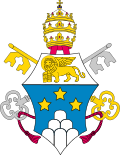Top Qs
Timeline
Chat
Perspective
Arched-hill symbol
From Wikipedia, the free encyclopedia
Remove ads
The Arched-hill symbol is a symbol on ancient Coinage of India. There are some variations to the number of the hills depicted, or the symbol surmounting the hill, such as a crescent or a star.

It is thought that the three-arched hill symbol was initiated during the Maurya Empire (3rd–2nd century BCE).[1] Later, in coins from Taxila dated from 220 BCE, the three-arched symbol appears regularly, and from 185 BCE is regularly associated with the animal figures of the elephant and the lion.[2] In contrast, the Nandipada is generally associated with the zebu bull.[3] On coins of the Shunga period, the three-arched hill can appear among a multitude of other symbols, such as the Nandipada, the tree-in-railing, the elephant, or the empty cross.[citation needed]
The symbol is generally considered a representation of a Buddhist Chaitya. It has also been argued that it was the imperial symbol of the Mauryas.[4] The symbol however, appears in many post-Mauryan contexts as seen with the coins of Taxila and the Shungas.
Remove ads
Gallery
- A Sunga coin (150 BCE-100 CE) with three-arched hill (reverse, top left) among other symbols.
- An Arched-hill symbol on the reverse of this Maurya Empire coin.
- Single-die local coinage of Taxila. Column and arched-hill symbol (220-185 BCE).
- Taxila coin (Post-Maurya, 185-160 BCE).
- A six-arched hill symbol with star on top, with tree-in-railing on a coin of Indo-Greek king Agathocles.
- A six-arched hill symbol on Pope John Paul I coat of arms. Fairly common in other coats of arms in Italy.
Remove ads
See also
References
Wikiwand - on
Seamless Wikipedia browsing. On steroids.
Remove ads






